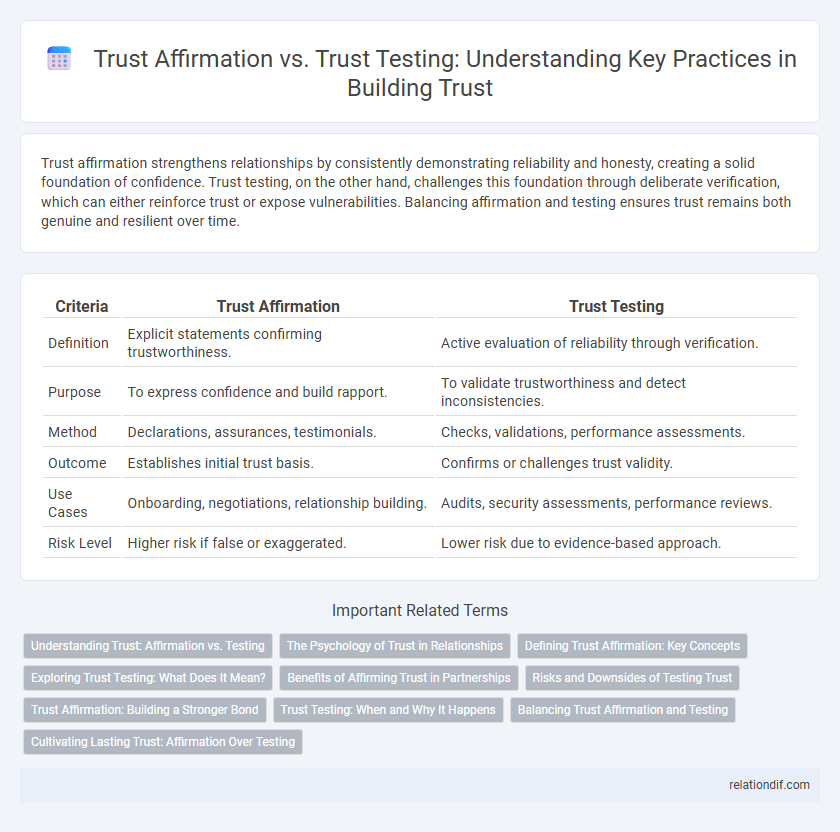Trust affirmation strengthens relationships by consistently demonstrating reliability and honesty, creating a solid foundation of confidence. Trust testing, on the other hand, challenges this foundation through deliberate verification, which can either reinforce trust or expose vulnerabilities. Balancing affirmation and testing ensures trust remains both genuine and resilient over time.
Table of Comparison
| Criteria | Trust Affirmation | Trust Testing |
|---|---|---|
| Definition | Explicit statements confirming trustworthiness. | Active evaluation of reliability through verification. |
| Purpose | To express confidence and build rapport. | To validate trustworthiness and detect inconsistencies. |
| Method | Declarations, assurances, testimonials. | Checks, validations, performance assessments. |
| Outcome | Establishes initial trust basis. | Confirms or challenges trust validity. |
| Use Cases | Onboarding, negotiations, relationship building. | Audits, security assessments, performance reviews. |
| Risk Level | Higher risk if false or exaggerated. | Lower risk due to evidence-based approach. |
Understanding Trust: Affirmation vs. Testing
Understanding trust involves distinguishing between trust affirmation, which reinforces confidence through consistent positive experiences and open communication, and trust testing, where deliberate challenges or evaluations gauge reliability and integrity. Trust affirmation builds emotional security by validating predictability and respect, while trust testing examines boundaries and authenticates commitment before deeper reliance is established. Both processes play critical roles in developing resilient relationships by balancing assurance with realistic appraisal.
The Psychology of Trust in Relationships
Trust affirmation enhances relational bonds by reinforcing positive expectations and emotional security, fostering a stable psychological environment. Trust testing, involving behaviors like reliability checks or honesty assessments, risks undermining confidence and creating anxiety, which may weaken relational trust over time. Psychological research indicates that consistently affirming trust supports attachment and reduces relational uncertainty more effectively than frequent trust testing.
Defining Trust Affirmation: Key Concepts
Trust affirmation involves openly expressing confidence and reliability through consistent actions and transparent communication, fostering a positive relational environment. It centers on reinforcing mutual respect and shared values, which strengthens the emotional bond between parties. Key concepts include sincerity, commitment, and ongoing validation that affirm trustworthiness without the need for skepticism or frequent verification.
Exploring Trust Testing: What Does It Mean?
Trust testing involves evaluating reliability and credibility through consistent actions and transparency rather than relying solely on verbal affirmations. This process examines behavioral evidence and response patterns to determine whether trust is justified in personal or professional relationships. Implementing trust testing strategies helps uncover authentic trustworthiness, enabling more informed decisions and stronger bonds.
Benefits of Affirming Trust in Partnerships
Affirming trust in partnerships fosters open communication and strengthens collaborative commitment, leading to higher productivity and innovation. Consistent trust affirmation reduces misunderstandings and mitigates conflicts, enhancing overall stability and long-term success. Partners experiencing affirmed trust demonstrate increased loyalty and willingness to share critical information, creating a resilient and adaptive business environment.
Risks and Downsides of Testing Trust
Trust testing introduces risks such as damaging relationships through perceived suspicion, which can lead to decreased communication and increased conflict. This approach often undermines trust by signaling doubt, causing emotional stress and reducing cooperation. Instead, trust affirmation fosters a positive environment by reinforcing confidence and mutual respect, minimizing the downsides linked to testing behaviors.
Trust Affirmation: Building a Stronger Bond
Trust affirmation reinforces positive expectations and strengthens emotional connections by consistently expressing reliability and honesty in relationships. It fosters a secure environment where individuals feel valued and supported, promoting deeper understanding and cooperation. Emphasizing trust affirmation over trust testing cultivates resilience and mutual respect, leading to more enduring and meaningful bonds.
Trust Testing: When and Why It Happens
Trust testing occurs when uncertainty or risk necessitates verification of reliability and integrity, often triggered by past breaches or high-stakes decisions. Organizations and individuals initiate trust testing to evaluate consistency, predict behavior, and mitigate potential vulnerabilities before committing significant resources. This process enhances confidence but may introduce friction if overused, making timing and context critical for effective trust validation.
Balancing Trust Affirmation and Testing
Balancing trust affirmation and trust testing is essential for maintaining healthy personal and professional relationships by reinforcing confidence while ensuring reliability. Trust affirmation involves consistent positive feedback and transparency, which fosters emotional security and commitment. Trust testing, when applied judiciously, verifies dependability and uncovers potential issues without undermining established trust or creating suspicion.
Cultivating Lasting Trust: Affirmation Over Testing
Cultivating lasting trust hinges on consistent affirmation that reinforces reliability and integrity, enabling deeper emotional connections and sustained cooperation. Trust affirmation nurtures positive expectations and mutual respect, whereas trust testing often breeds doubt and defensiveness, potentially weakening relationships. Prioritizing affirmation fosters a foundation of security and openness essential for enduring trust in both personal and professional contexts.
Trust affirmation vs trust testing Infographic

 relationdif.com
relationdif.com